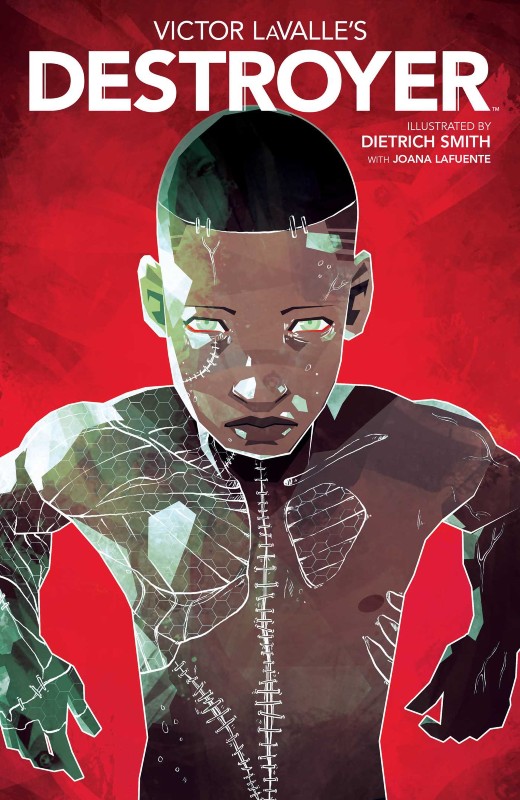In “Destroyer,” Victor LaValle Revisits Frankenstein’s Monster

I’ve had Frankenstein retellings on the brain lately, apparently. It might be the looming release of the film adaptation of the novel Poor Things, which offers a unique riff on Mary Shelley’s novel, or it might just be the fact that we’re getting closer to the end of October. Whichever it is, it seems worth noting that comic books have also had their share of riffs on a mad doctor, their creation, and the friction that ensues.
Legendary artist Bernie Wrightson has a distinctive spin on Shelley’s character, while Mark Russell and Peter Snejbjerg’s Cereal offers an intriguing riff on the phenomenon of horror-themed breakfast cereal mascots. And then there’s Destroyer, from writer Victor LaValle and artist Dietrich Smith. (Joanna LaFuente handled colors, and Jim Campbell is responsible for the book’s lettering.) This was, I believe, LaValle’s first high-profile foray into comics; he’s since followed that with the science fictional story Eve and a pair of miniseries for Marvel centered around the longtime Wolverine antagonist Sabretooth.

Destroyer is structured as a direct sequel to Shelley’s novel, set in the present day (or possibly the near future). When the book opens, Frankenstein’s monster is living in isolation in the Arctic, seemingly peacefully. This changes — and does so quickly — when a whaling vessel comes into range and begins going about its business. The monster makes short work of the whalers — an image early on of him tearing the heart from the chest of one sailor hints at more bloodshed to come. From there, the monster makes his way to another ship, and from there he returns to the human world.
This part of the story is a familiar one — albeit with more than a few narrative beats that zig where you might expect it to zag. (More on that momentarily.) Frankenstein’s monster is not at the center of this book, however — instead, it’s the life’s work of another gifted scientist. That would be Dr. Baker, a brilliant thinker with ties to a very secret government program and plenty of secrets of her own. Smith’s visuals of Dr. Baker — both in the present-day sequences, with a shock of white in her hair, and in flashbacks to her in happier times — make for a distinctive central character, capable of stunning acts of love and haunted by grief.
Her ongoing project is the resurrection of her son Akai, who was killed at the age of 12 by a police officer. At one point, Dr. Baker discusses the moment in which grief transforms into rage, citing comments made by Myrlie Evers in the wake of the murder of her husband Medgar. “The depth of her hatred was indescribable,” Dr. Baker recalls.
Destroyer abounds with interesting uses of technology, from the nanotechnology that both returns Akai to life and gives him distinct abilities of his own. But just as Frankenstein sits at the root of both science fiction and horror, so too does Destroyer.
It would be easy for LaValle to depict the Monster as a charming antihero, but he’s more than willing to kill his way through the humans he encounters — or, in a few shocking moments, to let innocents die. Dr. Baker’s fury at the world feels more and more like a tragic flaw as the book nears its conclusion. As for the pair of wisecracking government agents who would be comic relief in another book; here, each one is given a moral test. Each fails it.
It’s telling that Akai — the only member of a younger generation to have a significant role in the novel — is portrayed as being the sole character seeking to move away from cycles of violence and trauma. His role in the book also suggests that Mary Shelley’s novel isn’t the only classical work that LaValle is alluding to here.
Alternately, it's telling that there is a character here who dies in a horrific act of state-sponsored violence, is resurrected, and has the ability to transform ordinary objects into something miraculous. To say nothing of the fact that this character is able to extricate himself from some of the violence and vengeance that surrounds him.
It’s one of several ways in which Destroyer doesn’t go where you think it’s going to go. And it helps to make for a book that hearkens back to the classics, even as it has plenty of things to say that Mary Shelley might never have imagined.
Thanks for reading! Next up — though I'm not sure in what order they'll be appearing — Si Spurrier and Charlie Adlard's Damn Them All and Chantal Montellier's Social Fiction.